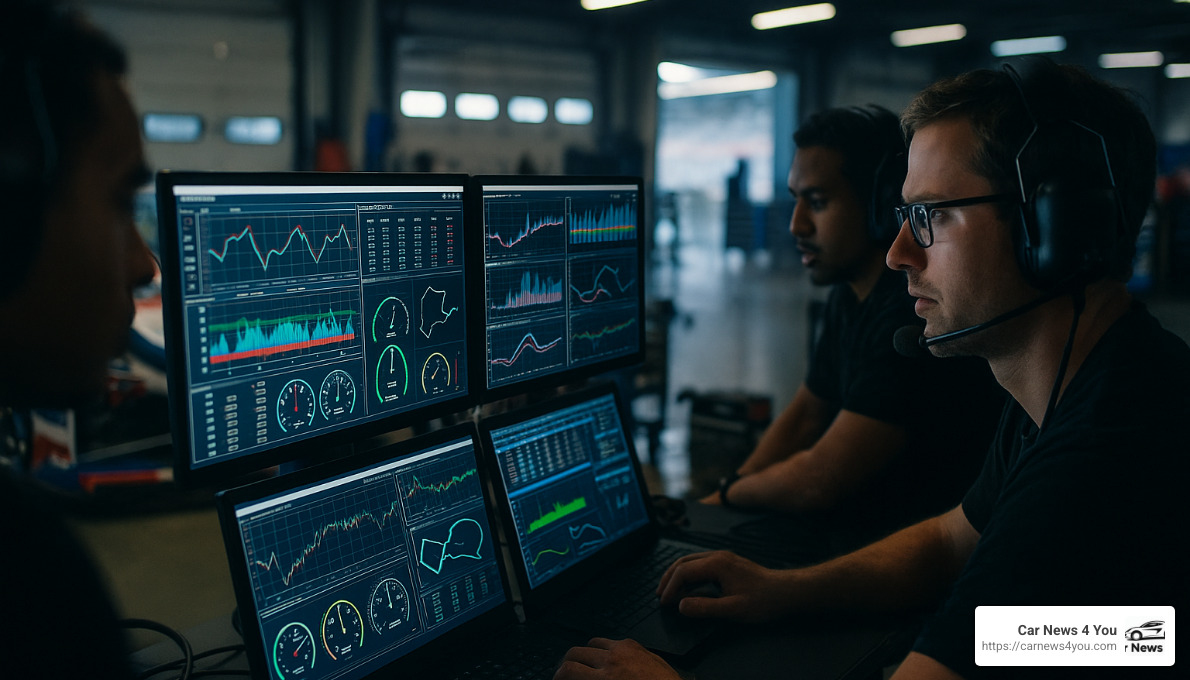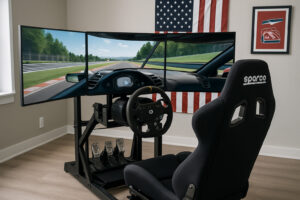Race car telemetry systems: Top 10 Revolutionary Insights
Racing’s Digital Nervous System
Race car telemetry systems are sophisticated data collection networks that transmit real-time performance information from a racing vehicle to engineers and team members. If you’re looking to understand these systems quickly, here’s what you need to know:
| Key Aspects of Race Car Telemetry | Description |
|---|---|
| Primary Function | Collects and transmits real-time data from 80+ sensors on the race car |
| Key Components | Sensors, data loggers, transmitters, receivers, analysis software |
| Data Captured | Engine metrics, chassis dynamics, tire performance, G-forces, temperatures |
| Transmission Methods | WiFi, Bluetooth, 4G LTE, 5G cellular networks |
| Benefits | Performance optimization, strategic decision-making, driver coaching |
On modern race cars, telemetry has become as essential as the engine itself. These systems provide the critical link between what’s happening on the track and the decisions made in the pit.
As one race team engineer put it: “Hands-down, one of the biggest challenges is vibration.” Yet despite the harsh conditions of motorsport, today’s telemetry systems deliver astonishing reliability, with many capable of transmitting data at 10-20 samples per second during live racing.
The technology has transformed how teams approach racing strategy. No longer must engineers wait for a pit stop to download and analyze data – they can make real-time adjustments based on continuous feedback. This immediate insight gives teams a competitive edge that would have seemed like science fiction just decades ago.
Whether you’re an amateur racer looking to improve your lap times or a professional team seeking that championship-winning advantage, understanding telemetry is crucial in modern motorsport.

Understanding Race Car Telemetry Systems
Race car telemetry systems represent the fascinating marriage between high-speed motorsport and cutting-edge data technology. What was once a sport guided primarily by driver feel and mechanic intuition has transformed into a precision science, where every millisecond and movement is captured, analyzed, and optimized.

What are Race Car Telemetry Systems?
At their heart, race car telemetry systems are sophisticated data networks that serve as the car’s digital nervous system. Think of them as the ultimate performance storytellers – capturing every whisper and scream from your race car and translating it into actionable insights.
These systems excel at three primary functions that work together seamlessly. First, they’re master data collectors, with sensors throughout the vehicle capturing everything from the obvious (engine RPMs, throttle position) to the subtle (suspension compression rates, tire temperatures). An Indy car bristles with dozens of sensors monitoring everything from fuel mixture to the tiniest changes in aerodynamic pressure.
Next comes data transmission – the crucial bridge between car and pit wall. Modern systems send this flood of information wirelessly in real-time, allowing engineers to virtually “ride along” with their drivers. Whether through WiFi for short-range applications or increasingly through cellular networks like 4G LTE and 5G for complete track coverage, this continuous data stream keeps teams constantly informed.
Finally, sophisticated analysis software transforms raw numbers into racing intelligence. The best systems don’t just collect data – they help teams understand it through intuitive visualizations, comparative analysis, and even predictive modeling.
As Lauren Elkins from Win Autosport LMP2 Team enthusiastically shared: “We had coverage around the entire track – something NONE of us on the engineering staff have ever experienced here at Road America. I cannot thank you enough for building such a great system and providing such amazing support.”
How Race Car Telemetry Systems Improve Performance
The impact of race car telemetry systems on racing performance is nothing short of revolutionary, touching every aspect of competition.
For drivers, telemetry serves as a digital coach that never tires. It provides immediate feedback on braking points, revealing where they’re braking too early or too late. It highlights cornering efficiency, showing exactly where they’re losing time through suboptimal lines. And perhaps most valuably, it offers predictive lap timing that tells them in real-time whether they’re gaining or losing ground compared to their best performance.
Race engineers gain an unprecedented window into their vehicle’s soul. Rather than waiting for a driver’s subjective feedback, they can see precise performance metrics across hundreds of parameters. This allows for data-driven setup changes that might be imperceptible to even the most sensitive driver but can shave crucial tenths off lap times. Engineers can also spot developing mechanical issues before they become race-ending failures – like detecting a gradual temperature increase that might signal an impending cooling system problem.
For team strategists, telemetry transforms race management from educated guesswork to scientific precision. They can make optimal pit stop decisions based on real fuel consumption data rather than conservative estimates. They can integrate weather pattern analysis with tire performance data to make perfect tire choices as conditions change. And they can perform competitive analysis by comparing their car’s sector times against competitors to identify strategic advantages.
A Bentley GT3 Engineer from M Sport summed it up perfectly: “The support from Control is second to none. Just when you thought it couldn’t get any better they announce a new release and how they have made improvements that make it easier for the customer to set up and ensure the telemetry is 100% reliable. They are truly the market leader in motorsport telemetry!”
In today’s ultra-competitive racing environment, where victories are often decided by fractions of a second, race car telemetry systems have become as essential as the engine itself. They represent the difference between racing on instinct and racing with intelligence – and in modern motorsport, the latter almost always takes the checkered flag.
Key Components of Race Car Telemetry Systems
A comprehensive race car telemetry system isn’t just a single gadget – it’s a symphony of specialized parts working together to give racing teams their competitive edge. Let’s peek under the hood at what makes these systems tick.

Sensors
Think of sensors as the system’s eyes and ears. Modern race cars are absolutely packed with them – typically 80 or more dotting the vehicle from nose to tail.
Engine sensors keep tabs on everything happening under the hood – RPM, throttle position, fuel pressure, oil levels, and exhaust temperatures. Without these, teams would be flying blind on the most critical part of the car.
Chassis sensors are the tattletales of the suspension world. They report on suspension travel, ride height, steering angle, and brake pressure, helping engineers understand how the car behaves through every twist and turn.
The car also needs to know what’s happening around it. Environmental sensors track ambient temperatures, humidity, and track conditions – crucial info for tire strategy and engine tuning.
One of the most impressive components are the Inertial Measurement Units (IMUs). These high-tech marvels measure g-forces, yaw, pitch, and roll up to 1000 times per second! That’s like having a tiny astronaut inside your car reporting on every force it experiences.
The GNSS/GPS receivers aren’t your average navigation systems either. They tap into multiple satellite networks (GPS, Beidou, GLONASS, Galileo) to pinpoint the car’s position up to 25 times per second.
As one race engineer put it, “These sensors need to be tougher than the drivers.” They operate reliably at temperatures approaching 175°C while being shaken like a maraca and pulled by forces that would make a fighter pilot dizzy.
Data Loggers
If sensors are the eyes and ears, data loggers are the brain collecting all that information. These compact powerhouses serve as the central nervous system of the telemetry setup.
Top-tier systems like the RaceCapture/Pro MK4 and PodiumConnect MK2 can sample data up to 1000 times per second – that’s collecting information faster than you can blink! They feature dual CAN bus channels that communicate at speeds up to 1MBPS and can store up to 32GB of data on onboard SD cards.
For weekend racers with modern vehicles, many loggers offer direct OBD-II integration, supporting up to 20 channels of vehicle data without additional sensors. The most advanced units can map and monitor over 100 CAN channels simultaneously – that’s a lot of numbers to crunch!
Communication Modules
All that brilliant data isn’t worth much if it stays trapped in the car. Communication modules are the messengers that get information from the speeding vehicle to the anxious pit crew.
WiFi connections offer lightning-fast data transfer but only work when the car is within range – perfect for pit stops or when passing the main straight. Modern systems can transmit at rates up to 50Hz through WiFi.
Bluetooth handles device connectivity and medium-range transmission, often used for driver-to-pit communication or connecting to nearby devices.
The game-changer has been 4G LTE and 5G cellular connectivity. These technologies allow teams to monitor cars anywhere on the track and even at testing venues across the globe. 4G systems typically transmit at 10Hz, while newer 5G systems push even higher rates with better reliability.
The cutting-edge TLM-P1 Evo represents the pinnacle of this technology – the world’s first 5G motorsport telemetry system with three simultaneous cellular connections and a built-in Ethernet switch. Talk about staying connected!
Data Analysis Software
Having mountains of data doesn’t help if you can’t make sense of it. This is where analysis software transforms raw numbers into race-winning decisions.
Real-time dashboards give teams customizable interfaces showing exactly what they need to see, when they need to see it. Critical tire temperatures? Engine parameters approaching limits? It’s all there at a glance.
Predictive analysis tools are perhaps the most impressive feature, using sophisticated algorithms to forecast lap times and performance trends. Engineers can see the future – or at least a very educated guess at it.
Teams rely heavily on comparative analysis features that allow side-by-side evaluation of different laps, drivers, or setup configurations. This answers the crucial question: “Is what we’re doing actually making us faster?”
When something goes wrong, alert systems instantly notify the team about anomalies or threshold violations. That strange vibration might be nothing – or it might be a component about to fail catastrophically.
Many modern packages include video integration that synchronizes data with onboard camera footage, creating a complete picture of what happened and why. It’s like having the driver’s perspective with a data overlay.
For smaller teams and weekend warriors, mobile applications have made this technology more accessible than ever, allowing telemetry monitoring on smartphones and tablets without expensive equipment.
Looking to build your own high-performance toolkit beyond telemetry? Check out our guide to Essential Tools Every Car Enthusiast Should Have in 2025.
How Real-Time Data Transmission Works
Have you ever wondered how race teams can instantly know what’s happening in a car that’s zooming around a track at 200+ MPH? It’s not magic – it’s the wonder of modern race car telemetry systems and their incredible data transmission capabilities.

Think of telemetry as a continuous conversation between your race car and your team. The car is constantly “talking,” sharing everything from engine temperature to tire pressure, and this digital conversation needs to happen without missing a beat.
Inside the car, sensors communicate with a central data logger – think of it as the car’s brain – through either physical wires or short-range wireless connections. This brain then packages all this valuable information and sends it to the pit crew using various wireless technologies.
Some teams rely on WiFi when the car is close to the pits, offering tremendous data bandwidth but limited range. Others use specialized radio frequency systems operating in the 430-470 MHz range for more consistent coverage around the track. But the real game-changer in recent years? Cellular networks.
The Benefits of Using 4G LTE and 5G in Telemetry Systems
The adoption of cellular technology has truly revolutionized how teams monitor their cars during races. With 4G LTE connectivity, teams now enjoy:
Global coverage that works at virtually any track on the planet – no more setting up complex trackside equipment for each new venue. Your telemetry system simply connects to local cell towers, and you’re ready to race.
Reliable data rates up to 10Hz give teams a consistent flow of information about vehicle performance. That means 10 updates every second – plenty to make informed decisions during a race.
Smart reconnection systems that automatically find and reestablish connections if they’re temporarily lost, ensuring you don’t miss critical data even in challenging signal environments.
But as impressive as 4G has been, 5G technology is taking telemetry to breathtaking new heights with:
Ultra-low latency that practically eliminates the delay between something happening in the car and the team seeing it on their screens – we’re talking milliseconds here.
Massive bandwidth increases that allow for higher sampling rates and more detailed data collection. Instead of 10 updates per second, teams can potentially receive 50 or more.
Improved reliability in crowded race environments where thousands of spectators are also using cellular networks.
The cutting-edge TLM-P1 Evo device showcases just how far we’ve come, supporting multiple simultaneous cellular connections for redundancy. If one network has issues, the system automatically routes data through another – ensuring teams never lose touch with their drivers.
Behind all this wireless wizardry is some serious data management smarts. These systems don’t just blindly transmit everything – they’re constantly making decisions about what’s most important. Critical parameters like engine temperature and oil pressure get priority treatment, while data compression squeezes the maximum information into the available bandwidth.
When connectivity drops (which can happen even with the best systems), built-in buffering temporarily stores data and automatically transmits it when the connection returns – ensuring nothing gets lost.
All this sophisticated technology operates with remarkable efficiency. The RN Telemetry system, for example, uses just 30MB of data for a full hour of racing. Even a grueling 24-hour endurance race consumes only about 720MB – less than a single high-definition movie.
For racing teams, this real-time flow of information isn’t just cool technology – it’s the difference between winning and losing, or sometimes between a safe race and a dangerous mechanical failure.
For more on how this technology continues to evolve, check out Advancements in Race Car Telemetry.
The Role of Predictive Lap Timing in Racing
Predictive lap timing is where the rubber really meets the road when it comes to race car telemetry systems. It’s the feature that transforms raw data into something drivers and teams can actually use in the heat of competition.

How Predictive Lap Timing Works
Think of predictive lap timing as your personal racing crystal ball. Unlike traditional timing that only tells you how you did after you’ve completed a lap, predictive timing tells you how you’re doing right now, and how your lap is likely to finish.
First, the system needs a reference – usually your best lap of the day or an ideal composite lap pieced together from your best sectors. As you drive, sophisticated algorithms compare your current performance against this reference in real time.
The magic happens when the system continuously recalculates your projected finish time with each passing meter of track. You’re braking later into Turn 3? The system instantly factors that in. Carried more speed through the chicane? Your predicted time adjusts accordingly.
What makes this information truly valuable is how it’s delivered. Most systems use intuitive color-coded displays – green numbers when you’re gaining time, angry red when you’re losing it. The RaceCapture/Pro MK4 takes this further with an interactive track map builder featuring over 100 pre-loaded tracks, so you’re never flying blind at a new circuit.
Benefits for Drivers and Teams
For drivers, predictive lap timing is like having a coach riding shotgun. Instead of waiting until you pit to learn you’re losing time in the hairpin, you know immediately. This instant feedback creates a tighter learning loop – make an adjustment to your line, and see the impact right away.
“The first time I used predictive timing, it completely changed how I approached practice sessions,” says amateur racer Mike Donovan. “I could experiment with different braking points and immediately see if I was gaining or losing time. My learning curve accelerated dramatically.”
For race engineers and coaches, this technology is equally revolutionary. When a driver reports the car feels better after a suspension adjustment, the engineer doesn’t need to wait for a complete lap to verify – they can see sector times improving in real time. This speeds up the setup process enormously, especially during limited practice sessions.
Teams with multiple drivers benefit too. Engineers can quickly spot where Driver A is gaining time over Driver B, allowing for targeted coaching. “Hey Sam, notice how Julie is carrying more speed through Turn 7? Try delaying your throttle application until after the apex.”
Time-Gap Analysis and Sector Timing
Modern predictive systems go well beyond simple lap predictions. They break tracks into multiple sectors – sometimes as many as 20 or more – allowing for microscopic analysis of performance.
Delta time displays show not just that you’re 0.3 seconds behind your best lap, but exactly where that time was lost. Was it a single mistake, or death by a thousand cuts across multiple corners? This granular insight helps drivers focus their improvement efforts where they’ll have the biggest impact.
Some advanced systems even overlay your current path with the ideal racing line, highlighting when you’re deviating from the optimal track position. This visual guidance is especially valuable for newer racers still developing their track awareness.
What’s particularly exciting is how this technology has democratized professional-level coaching. Features that were once available only to Formula 1 teams are now accessible to weekend warriors at their local track day. A smartphone mounted to the dashboard running the right app can provide insights that would have required a team of engineers just a decade ago.
As racing continues to evolve into an increasingly data-driven sport, predictive lap timing stands out as one of the most driver-focused applications of race car telemetry systems – translating complex data into actionable insights that help racers at every level push their limits safely and effectively.
Integrating Telemetry Systems with Existing Data Acquisition Platforms
Let’s face it – most race teams don’t start from scratch. You’ve likely already invested in data acquisition systems from brands like AiM, MoTeC, or Race Technology. So how do you add modern telemetry without throwing out all your existing gear? That’s the real challenge: creating a seamless data ecosystem where everything works together.

Integration Challenges and Solutions
Think of adding telemetry to your existing setup like introducing a new teammate to a well-oiled crew. There’s always an adjustment period, but with the right approach, the integration can be surprisingly smooth.
When it comes to protocol compatibility, it’s a bit like language barriers. Your existing systems might speak “MoTeC” while your new telemetry speaks “CAN.” Modern solutions bridge this gap with multi-protocol support that acts like a universal translator. The best systems support standard interfaces like CAN, RS232, and Ethernet, with protocol translation modules that interpret between different systems.
Space is always at a premium in race cars – where exactly do you put new hardware when every inch is already accounted for? This is where clever engineering comes in. The latest telemetry solutions like the PodiumConnect MK2 are specifically designed with compact form factors to squeeze into tight spaces. Some systems offer modular designs that can be distributed throughout the vehicle, rather than requiring one large installation space.
Power management is another headache that’s been thoughtfully addressed. Adding telemetry hardware increases the drain on your electrical system, but modern units include low-power modes during non-critical periods and smart sleep functions that activate during pit stops. This prevents your telemetry from becoming an energy vampire.
Dual CAN Bus Architecture
The CAN (Controller Area Network) bus has become racing’s digital nervous system, and the smartest race car telemetry systems leverage a dual CAN approach that keeps everything running smoothly.
Think of it like having two separate highways: your primary CAN bus connects to the vehicle’s existing ECU and sensor network, handling all the critical vehicle functions. The secondary CAN bus is dedicated just to telemetry sensors and modules. This separation isn’t just about organization – it’s about safety and performance.
By keeping these systems separate, you prevent telemetry issues from affecting critical vehicle systems. It’s like having a backup power grid for your city – if one goes down, the other keeps running. This approach also prevents data traffic jams that could slow down your vehicle’s performance.
The flexibility is impressive too. Systems like the RaceCapture/Pro MK4 support up to 100 direct CAN mapping channels with built-in presets for popular ECUs. This means you’re not starting from zero when setting up your integration – much of the hard work has already been done for you.

Data Synchronization and Unified Analysis
The magic happens when all your data sources work together in perfect harmony. Think about orchestrating a symphony where every instrument needs to play at exactly the right moment – that’s what good data synchronization feels like.
Time synchronization is the conductor of this orchestra. GPS time stamping ensures all data sources share a common reference point, with sub-millisecond precision alignment. This means when you see a spike in engine temperature, you can immediately correlate it with other events happening at that exact moment – perhaps a sudden change in throttle position or fuel pressure.
The user experience transforms with unified dashboards that bring together data from both your original systems and new telemetry sources. These customizable interfaces put the most relevant information at your fingertips, allowing you to cross-reference different data streams with just a few clicks. It’s like having a mission control center for your race car.
Behind the scenes, comprehensive data storage keeps everything organized in centralized repositories. Smart backup strategies prevent data loss if any single system fails, while automated merging combines onboard logged data with real-time telemetry for post-race analysis.
The PodiumConnect MK2 exemplifies this integration philosophy. It’s specifically designed to add real-time telemetry capabilities to cars with existing data systems from manufacturers like AiM and MoTeC. For teams making the transition to live data streaming, it creates an experience that feels natural and intuitive rather than like learning an entirely new system.
Data synchronization isn’t just a technical achievement – it’s what transforms individual data points into actionable racing intelligence that can make the difference between victory and second place.
Overcoming Challenges in Implementing Telemetry Systems
Putting race car telemetry systems into action isn’t exactly a walk in the park. Racing environments throw a unique set of challenges at these sophisticated electronics, and solving these problems has become something of an art form in the motorsport world.
Environmental Factors: The Vibration Challenge
Ask any race engineer about their biggest telemetry headache, and you’ll likely get the same answer. As one data acquisition specialist put it: “Hands-down, one of the biggest challenges is vibration.”
This isn’t your everyday smartphone-in-your-pocket vibration. We’re talking about constant, violent shaking that can literally shake components apart. Modern race cars generate vibrations that would quickly destroy consumer electronics. Teams tackle this by mounting telemetry units on special shock-absorbing materials and keeping them away from the worst vibration areas (ideally under 6g).
The installation manual for the FM 40 transmitter doesn’t mince words: “Do not install the unit near the engine (temperature and vibration may cause damage or malfunction).” Instead, these sensitive electronics find homes in the more protected areas of the vehicle, cushioned against the brutal forces of racing.
Temperature Extremes
If vibration wasn’t enough, race cars also create temperature environments that would melt or fry standard electronics. Engine compartments can reach scorching temperatures, while brakes can glow red-hot during hard racing.
Race car telemetry systems must withstand this thermal assault. Many sensors operate reliably at a blistering 175°C (347°F) – hot enough to bake cookies! Engineers carefully position components away from heat sources like exhaust systems and engine blocks, sometimes adding active cooling for particularly sensitive elements.
The CAN transceivers used in motorsport telemetry aren’t your average computer parts – they’re specially designed to function at temperatures approaching 150°C, far beyond what you’d find in everyday electronics.
Reliability in Harsh Conditions
Beyond the shake-and-bake challenges, race cars expose electronics to a cocktail of other punishing conditions.
Water, oil, fuel, dirt – all these contaminants would quickly destroy unprotected circuits. That’s why serious race car telemetry systems come in IP67-rated enclosures that can withstand dust storms and water immersion. Many feature hermetic seals to keep out fluids and special Gore-Tex membranes that equalize pressure while blocking contaminants.
Electromagnetic interference presents another invisible enemy. With powerful ignition systems and electrical motors creating electromagnetic noise, telemetry signals can easily become corrupted. Engineers combat this with shielded cables, careful grounding (especially tricky on carbon fiber chassis), and sophisticated digital filtering algorithms that separate the signal from the noise.
And let’s not forget the physical stresses – the high g-forces of cornering, acceleration, and braking that try to rip components from their mountings. Reinforced mounting points, strain relief for cables, and redundant fastening methods all help keep everything in place when the forces build.
Rugged Hardware Design
The philosophy behind racing telemetry hardware is clear: build it tough without adding unnecessary weight or bulk.
Modern units like the RaceCapture/Pro MK4 pack impressive capability into a package measuring just 150 x 85 x 30mm and weighing a mere 255 grams. The TLM-P1 Evo manages to fit multiple cellular connections and sophisticated processing power into a similarly compact design. This miniaturization is critical in racing, where every gram matters.
Connectivity is designed for speed and simplicity. As one manufacturer cheerfully describes their connector system: “Just plug everything together like LEGOs!” This might sound casual, but it reflects a serious design consideration – in the time-pressured environment of a race weekend, complex wiring that requires specialized tools or extensive troubleshooting simply won’t cut it.
For critical functions, redundancy is built in. The TLM-P1 Evo’s three simultaneous cellular connections ensure that data keeps flowing even if one or two networks fail – a belt-and-suspenders approach that reflects how vital this data has become to racing success.
Through purpose-built hardware and thoughtful installation practices, teams achieve remarkable reliability from their race car telemetry systems, even as their cars hurtle around tracks at 200+ mph in rain, heat, and punishing g-forces. It’s a testament to engineering ingenuity that these sensitive electronic systems can not only survive but thrive in one of the harshest environments technology can face.
Latest Advancements in Race Car Telemetry Technology
The world of race car telemetry systems is evolving at breakneck speed, with innovations that would have seemed like science fiction just a few years ago. Today’s cutting-edge technologies are changing how teams collect, transmit, and analyze data, creating exciting new possibilities for racing performance.

Multi-Constellation GNSS Technology
Remember when GPS was groundbreaking technology? Well, we’ve come a long way since then. Today’s advanced telemetry systems have acceptd what engineers call “quad-constellation” GNSS technology, and it’s a game-changer for racing.
These systems don’t just rely on America’s GPS satellites anymore. They simultaneously tap into Russia’s GLONASS, Europe’s Galileo, and China’s BeiDou networks. It’s like going from having one cell phone tower in your area to having four – suddenly your coverage is dramatically better.
For racers, this means pinpoint positioning accuracy that can get down to centimeter-level precision in good conditions. When you’re trying to hit the perfect racing line lap after lap, that kind of accuracy is pure gold. Systems like the RaceCapture/Pro MK4 now deliver position data at up to 25Hz – that’s 25 updates every second – giving teams unprecedented insight into exactly where the car is on track.
Even better, when your car dips under a bridge or through a tunnel, these new systems reconnect to satellites much faster than older technology. For tracks with urban sections or tree cover, the difference is night and day.
Ultra-High Sampling Rates
If you’ve ever watched old racing footage that looks choppy because it was filmed at 24 frames per second, you’ll appreciate why sampling rates matter in telemetry. Today’s systems are capturing data at rates that would make Hollywood jealous.
Modern analog channels can sample up to 1000Hz – that’s 1000 readings every second – for critical measurements like suspension position. To put that in perspective, the human eye can process around 60 frames per second. This ultra-fast sampling reveals subtle vehicle behaviors that were completely invisible before.
The latest Inertial Measurement Units (IMUs) combine accelerometers and gyroscopes to track the car’s movement in six dimensions. These sensitive instruments can detect things like chassis flex and suspension harmonics – tiny movements that can make the difference between a good lap and a great one.
“When we first saw the data coming in at these rates, it was like putting on glasses after needing them for years,” one race engineer told me. “Suddenly we could see problems we never knew existed.”
5G Connectivity Revolution
Perhaps nothing has transformed racing telemetry more dramatically than the arrival of 5G technology. The TLM-P1 Evo, the world’s first 5G motorsport telemetry device, has completely changed what’s possible in real-time data transmission.
With 5G, teams aren’t limited to just basic performance metrics anymore. They can transmit comprehensive data sets including high-definition video and audio – information that previously required physically connecting to the car during pit stops.
The bandwidth increase is massive, but what teams really love is the near-zero latency. When a driver reports a handling issue, engineers can see the relevant data almost instantly, allowing for immediate feedback and adjustments.
What’s particularly clever about the latest 5G systems is their redundancy. The TLM-P1 Evo maintains multiple simultaneous cellular connections, so if one network has a weak spot on the track, the system automatically routes data through stronger connections. It’s like having backup parachutes – something you really appreciate when you need it.
Advanced Data Analysis and AI Integration
Having mountains of data is one thing – making sense of it is another. This is where artificial intelligence and machine learning are making their mark on racing telemetry.
Today’s sophisticated analysis systems can automatically identify patterns that would take humans hours or days to spot. They can detect subtle signs of component wear before failures occur, potentially saving teams from costly DNFs (Did Not Finish results).
Some cutting-edge teams are even using “digital twin” technology – maintaining a virtual model of the car that updates in real-time based on telemetry data. This allows them to run “what-if” simulations during races: “If we change the tire pressure by 1 PSI, how will it affect our lap times in the next stint?”
AI-powered driver coaching systems are also emerging, comparing a driver’s inputs against ideal reference laps and highlighting specific areas for improvement. It’s like having a world-class driving coach who never gets tired or misses a detail.
Future Trends in Telemetry
Looking ahead, the telemetry landscape continues to evolve in fascinating ways. Wireless sensor networks are becoming more prevalent, with self-powered sensors that harvest energy from the vibrations and heat naturally present in a race car. These systems reduce weight and complexity by eliminating much of the wiring traditionally needed.
Augmented reality is also making inroads, with heads-up displays that show drivers critical telemetry data without taking their eyes off the track. Some teams are experimenting with AR systems for mechanics too, overlaying component status information directly in their field of view during pit stops.
Perhaps most encouraging is the trend toward standardization and democratization of telemetry technology. What was once the exclusive domain of top-tier factory teams is increasingly accessible to club racers and enthusiasts. Open-source analysis tools and standardized data formats are helping spread advanced techniques throughout the racing community.
As one amateur racer put it: “Five years ago, this kind of technology was Formula 1 only. Now I’m running it on my weekend track car, and it’s completely changed how I approach driving.”
The revolution in race car telemetry systems shows no signs of slowing down. If anything, the pace of innovation continues to accelerate – much like the cars these remarkable systems are designed to improve.
Frequently Asked Questions about Race Car Telemetry Systems
What are the primary functions of race car telemetry systems?
Ever wondered what’s actually happening inside those complex boxes attached to race cars? Race car telemetry systems do three main jobs that transform racing from guesswork into science.
First, they’re incredible data collectors. Think of them as the car’s nervous system, constantly gathering information from dozens of sensors throughout the vehicle. A modern race car typically has over 80 sensors monitoring everything from how hot the engine is running to how much the suspension is compressing in corners. Some of these sensors sample data up to 1000 times per second – that’s like taking a thousand snapshots of the car’s performance every second!
Second, they’re amazing communicators. The system wirelessly transmits all this information from a car that might be traveling at 200+ mph to the team in the pits. Whether using WiFi, Bluetooth, or cellular networks, this happens in real-time, giving engineers immediate insight into what’s happening on track.
Finally, they transform raw numbers into racing intelligence. The system processes this flood of data into readable dashboards, alerts, and visualizations that humans can actually understand and act upon. It’s like having X-ray vision into the car’s performance.
As one engineer put it, “Before telemetry, we were basically guessing. Now we know exactly what’s happening in real-time.”
How do telemetry systems improve race performance?
Race car telemetry systems have completely transformed how teams approach racing, bringing benefits that touch every aspect of performance.
For drivers, telemetry provides immediate feedback that accelerates improvement. Instead of relying on feel or memory, drivers can see exactly where they’re gaining or losing time. A coach can radio to a driver, “You’re braking 10 meters too early in Turn 3,” allowing for immediate adjustment rather than waiting until after the session. This real-time coaching turns good drivers into great ones much faster than traditional methods.
For engineers, telemetry eliminates the guesswork in car setup. When a driver reports the car feels “loose” in certain corners, engineers can immediately check suspension data, tire temperatures, and aerodynamic loads to pinpoint the exact cause. A tiny adjustment to wing angle or tire pressure can be evaluated on the next lap, with the data showing precisely what changed.
For strategists, telemetry transforms race planning. Teams can monitor fuel consumption down to the milliliter, predict exactly when tires will start to degrade, and spot developing mechanical issues before they become catastrophic failures. As one race engineer noted, “We once spotted a slow oil pressure drop that would have led to engine failure. We called the driver in early and saved the race.”
The preventative maintenance aspect alone justifies the investment for many teams. By tracking component lifecycles and identifying unusual patterns in the data, teams can prevent expensive failures and DNFs (Did Not Finish results).
A Bentley GT3 Engineer from M Sport summed it up perfectly: “The support from Control is second to none. Just when you thought it couldn’t get any better they announce a new release and how they have made improvements that make it easier for the customer to set up and ensure the telemetry is 100% reliable.”
What are the benefits of using 4G LTE and 5G connectivity in telemetry systems?
The cellular revolution has completely transformed race car telemetry systems in recent years, with 4G LTE now standard and 5G rapidly changing the game even further.
Perhaps the biggest benefit is global accessibility. In the past, teams needed to set up complex receiver networks around each track – expensive, time-consuming, and prone to dead spots. With cellular technology, you can transmit data from virtually any race track on the planet. As one team manager told me with a laugh, “We were testing at a remote track in Spain, and I was watching our telemetry data on my phone while sitting in a café in London!”
The reliability improvements are dramatic too. Modern systems feature clever reconnection algorithms that automatically reestablish connections if they drop. Premium systems like the TLM-P1 Evo take this even further, supporting three simultaneous cellular connections. If one network has a weak spot at a certain part of the track, the system automatically routes data through the stronger networks – it’s like having backup internet connections that kick in instantly when needed.
Data rates have taken a massive leap forward as well. While early telemetry systems might transmit a few key parameters once per second, 4G LTE supports comprehensive data at up to 10Hz (10 times per second). With 5G, we’re seeing bandwidths that can handle not just traditional telemetry but also integrated video feeds and much higher sampling frequencies.
The reduced latency of 5G is particularly exciting for driver coaching. When an engineer spots something and radios the driver, that communication happens almost instantaneously. A tenth of a second delay might not sound like much, but when a car is traveling at 180mph, that’s 26 feet of track – the difference between hitting the perfect braking point and missing it completely.
Perhaps most importantly, cellular technology has democratized telemetry. Small teams and amateur racers who could never afford proprietary systems can now access sophisticated real-time analysis through standardized cellular connections and cloud-based software. The playing field is leveling, and that’s great news for motorsport as a whole.
Conclusion
Race car telemetry systems have transformed from exotic technology once exclusive to Formula 1 teams into accessible tools that benefit racers at every level. Throughout this guide, we’ve seen how these systems represent the perfect marriage of motorsport passion and cutting-edge data science.
The impact of telemetry on racing simply cannot be overstated. Whether you’re an amateur driver trying to shave those precious seconds off your lap time or part of a professional team competing for championships, these digital nervous systems have fundamentally changed how we approach the sport.
What’s most exciting is how this technology has become available to everyone. Advanced features like predictive lap timing, multi-constellation GNSS, and cellular connectivity are now within reach of grassroots racers and weekend warriors. The playing field is leveling, allowing talent to shine regardless of budget.
I love how modern telemetry systems play nicely with existing data acquisition platforms. This means teams don’t have to rip out their current setup—they can improve their capabilities step by step, adding new features as budget and needs allow. It’s like upgrading your home entertainment system one component at a time rather than replacing everything at once.
Of course, racing presents unique challenges for any electronic system. The vibration alone would destroy most consumer electronics in minutes! That’s why purpose-built hardware is essential—equipment designed to withstand extreme vibration, scorching temperatures, and the physical stress of competitive motorsport.
The connectivity revolution has been a game-changer too. The transition to 4G LTE and now 5G cellular technology means you can get telemetry data from practically any track in the world without complicated receiver setups. Remember when teams needed dedicated radio receivers at each corner of the track? Those days are long gone.
Today’s systems don’t just collect data—they transform it into actionable insights through powerful software tools and intuitive interfaces that even non-engineers can understand. The data tells a story that helps teams make better decisions, faster.
As Lauren Elkins, Data Engineer at Win Autosport LMP2 Team, so eloquently put it: “We had coverage around the entire track – something NONE of us on the engineering staff have ever experienced here at Road America. I cannot thank you enough for building such a great system and providing such amazing support.”
Here at Car News 4 You, we’re committed to keeping you informed about the latest developments in racing technology. The telemetry revolution continues to accelerate, with new sensors, faster networks, and more sophisticated analysis tools emerging regularly. These advances not only improve competitive performance but also improve safety and reliability throughout motorsport.
Whether you’re a driver, engineer, team owner, or passionate fan, understanding telemetry has become essential to fully appreciating the technical side of modern racing. The days of relying solely on a driver’s subjective feedback are behind us—today’s motorsport combines human skill with data-driven precision to push the boundaries of what’s possible on track.
For more information about emerging trends in racing technology, visit our trends section where we regularly cover the latest innovations shaping the future of motorsport.








3 thoughts on “The Complete Guide to Racing Telemetry for Amateur and Pro Drivers”
Pingback: Steer Clear of Trouble with These Advanced Driving Tips - Car News 4 You
Pingback: Breakthrough Racing Technologies That Changed Motorsports Forever - Car News 4 You
Pingback: Why Automotive Connectivity Solutions Are the Next Big Thing - Car News 4 You
Comments are closed.